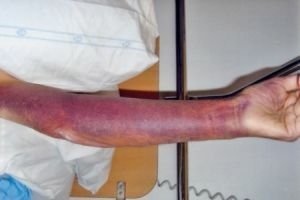 Phlebitis is the inflammation of the venous wall. The disease can be acute, chronic, or may occur in isolation.
Phlebitis is the inflammation of the venous wall. The disease can be acute, chronic, or may occur in isolation.
Changes in blood lines lead to the formation of thrombi and a smooth transition of the disease into thrombophlebitis.
The cause of inflammatory processes are mainly various infections. Also, an unsuccessful injection or an installed catheter on the arm can lead to phlebitis.
Contents of
- Contents of
- Contents of
- Types of the disease
- Types of the disease with their characteristics
- Clinical picture
- Diagnostic criteria and methods
- Complex therapeutic veins
- Disease
- Preventive measures
- Time to collect stones, or draw conclusions
- Contents of
Causes and risk groups
Inflammation of venous walls mainlyoccurs on the lower limbs. But violation of some rules, for example, intravenous 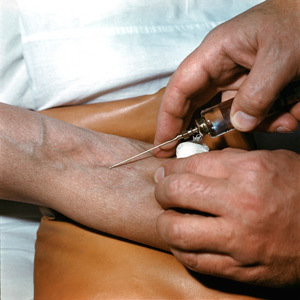 intervention outside the medical institution lead to disease by phlebitis on the hands. In the risk zone fall:
intervention outside the medical institution lead to disease by phlebitis on the hands. In the risk zone fall:
- alcoholics, injections which, when regular binges are put at home;
- patients undergoing detoxification procedures;
- addicts injecting into a vein and who use several times one syringe, they also use highly aggressive chemical solvents in the preparation of a surrogate, which leads to inflammation of the inner wall of the vessel.
The disease also develops due to the introduction of a jet medication into the vein or when injecting hypertonic mixtures with potassium chloride and calcium.
Based on provoking reasons, three main types of phlebitis are distinguished: chemical, mechanical and bacterial.
Other causes of the disease:
- multiple injections;
- wearing a catheter for a long time;
- varicose veins on the arms;
- trauma of the venous walls;
- existing foci of infections in the body: pathogenic microorganisms, boils, abscesses, abscesses, inflamed internal organs;
- load on the body due to pregnancy;
- is a sedentary lifestyle;
- enhanced physical activity.
- failure to comply with safety regulations during medical procedures, which can lead to chemical burns.
Species of the disease with their peculiarities
The localization of a part of the affected vein causes:
- endophlebitis - the inner shell of the vessel is affected;
- periphlebitis - the external wall of the vein becomes inflamed;
- pflebbit - the defeat of all the walls of the vessel.
The following varieties of phlebitis are also distinguished:
- Developing on the face of is another form of the disease that is localized around the neck and head of the patient. The reason is a purulent inflammation. It can be phlegmon, an abscess that is triggered by an infection.
- Postinjection .Characterized by the response to medications. Inflammation can arise from the chemical
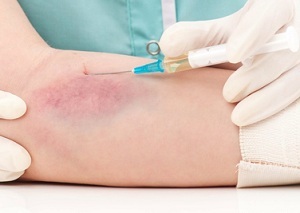 features of the injected drug or in connection with the mechanical action on the vessel walls.
features of the injected drug or in connection with the mechanical action on the vessel walls. - Kubital .When the vessels are forcibly irritated, by administering a drug that promotes the gluing of the veins. This procedure is present in sclerotherapy.
- Collision of the collar vein or pylephlebitis .The largest vein of the abdominal cavity is inflamed.
- Allergic wandering .It is considered an inflammatory inflammation, but will continue for a long time( up to several years).It affects the superficial veins of the lower and upper extremities, sometimes deep veins. Seals appear alternately in different areas, as if "jumping" from one zone to another. Young men are more likely than others to have this form of the disease.
- Cerebral .The vessels of the brain are affected. Inflammation occurs due to infection in the body.
- Painful .Accompanied by acute pain in women after the birth of a child.
The most dangerous form of the disease is thrombophlebitis. Foci of inflammation can be located in different parts of the human body. Based on localization of the venous lesion, thrombophlebitis can affect:
- of the lower extremities;
- of the upper limbs;
- internal organs;
- arteries( thrombosis of peripheral arteries).
Clinical picture
Symptoms that accompany the development of phlebitis on the hands:
- The affected superficial vein of the upper limbs shows itself with sudden painful attacks along the entire length;
- on the hand can be seen redness of the skin and swelling of soft tissues that spread with great speed from the injection site;
- lymph nodes increase.
- body temperature rises to 39 ° C.
- inflamed vein resembles a subcutaneous tourniquet, when viewed visually.
Diagnostic criteria and methods
 on the clinical symptoms of the disease is established by diagnosis. Among the hardware, ultrasound Doppler ultrasound or duplex scanning is used. Devices are chosen with respect to the anatomical location of the focus of the disease.
on the clinical symptoms of the disease is established by diagnosis. Among the hardware, ultrasound Doppler ultrasound or duplex scanning is used. Devices are chosen with respect to the anatomical location of the focus of the disease.
Transumblical portogeopathography and magnetic resonance imaging are performed in more complex situations, for example, with pylephlebitis. The apparatus receives additional data and conducts a portal vein study.
In cases of inflammatory and infectious diseases, differential diagnosis is used. For example, pylephlebitis differentiates with Kari's disease, sepsis, typhus and typhoid fever, abscess.
Differentiation of cerebral phlebitis with cerebral abscess, meningitis, encephalitis, arachnoiditis,
is also performed. Complex of therapeutic veins
The phlebitis of superficial veins is most often treated with conservative methods. Complex therapy is applied, as a result of which:
- is removed by inflammation with antibacterial drugs or anti-inflammatory drugs;
- reduces blood clotting due to blood thinners, this procedure reduces the risk of blood clots;
- strengthens the walls of the vessels and increases their elasticity.
Patient is assigned:
- ointment application( Troxevasin, Heparin);
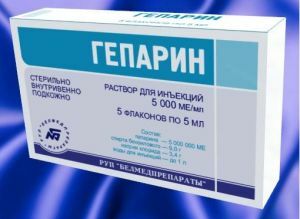
- medications that reduce prothrombin( Phenylin, Dicumarin);
- anticoagulants;
- physical procedures( infrared irradiation, UVP, sollyx).
Surgical intervention is possible only with complications( thrombosis) in the form of the following procedures:
- is a vein ligation;
- cuts the vein where the thrombus is formed;
- removes the inflamed area.
With the disease of superficial veins, folk medicine is used successfully:
- Vasodine compress with alcohol is applied to the inflamed area. This helps to relieve inflammation. The procedure is carried out in the following order: a cotton swab is wetted with alcohol and petrolatum is applied. Put the contents on the affected area and tie it with a bandage. Iodine grid .
- Compress ( buckwheat porridge, scalded with boiling water, and cabbage leaf on top).
- Ointment from horse chestnut .In its preparation, the bark and fruits of the tree are used. An equal amount of bark and fruits are dried and crushed into powder. Then, 2 tbsp. Spoons of the mixture are combined with 200 g of wine and put in a dark place for 3 days. The permanent mixture is placed on a fire and the liquid is evaporated until the content of the wine is reduced by a factor of 2.300 ml of sunflower oil or any vegetable oil is added to the contents. Ointment used for compresses on sore spots.
Danger of the disease
Any of the phlebitis causes the formation of thrombosis, which provokes the development of thrombophlebitis.
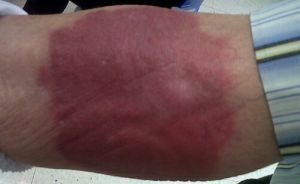 But the most dangerous acute phlebitis of deep veins. With this form, the thrombus is able to come off and move along the vessels with subsequent exposure to the pulmonary part. Here, in turn, the pulmonary artery occludes, which leads to a lethal outcome due to the formation of thromboembolism in it.
But the most dangerous acute phlebitis of deep veins. With this form, the thrombus is able to come off and move along the vessels with subsequent exposure to the pulmonary part. Here, in turn, the pulmonary artery occludes, which leads to a lethal outcome due to the formation of thromboembolism in it.
In this case, also a low tone of the vascular walls is observed and the viscosity of the blood increases. Based on these factors, a complex treatment of possible complications is carried out.
Purulent infectious complications are also often developed: phlegmon, abscess formation.
Preventive measures
To prevent the development of phlebitis, it is necessary:
- to pay attention to purulent skin lesions, infections and eliminate them in time;
- intravenous administration of medicines should be carried out according to all medical rules;
- to lead a healthy lifestyle;
- to exclude risks that cause vessel spasms( hypothermia of feet, smoking);
- to lead an active lifestyle and to give up a long stay in a sitting position, if the work is just such, take breaks with exercises, morning and evening walks, visit the pool;
- during sitting, you can not toss your foot on the leg;
- should walk in the fresh air for as long as possible;
- if there is a predisposition to varicose veins, conduct appropriate preventive procedures using ointments based on heparin;
- droppers should be placed without mechanical damage to the veins;
- once a year to conduct a blood test for viscosity and if necessary to dilute it to prevent thrombophlebitis.
Time to collect stones, or draw conclusions
Based on the above, we come to this opinion:
- Age and sex of the disease does not have .Everyone can get sick, and with equal probabilities both women and men of
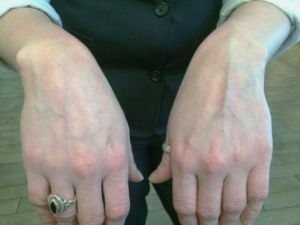 of different ages.
of different ages. - The cause of is in most cases an infection that affects any areas of the body.
- Symptoms of are determined relative to the area where the vessel is inflamed. The form of inflammation can be deep and shallow.
- The disease progresses in a chronic and acute .Unite all forms of the disease with such signs: fever, headaches, general weakness and hyperthermia of the inflamed zone.
- The companion of the disease is the varicose veins .
- Any form of disease can trigger the onset of thrombophlebitis .
At the first symptoms, you should consult a phlebologist who is a specialist in the appropriate field, timely treatment of the disease will save the patient from serious consequences and complications.
